The amount of insulation that you need for 10×16 shed depends on things like the roof design, stud size, and stud spacings. Because of this, the amount can vary.
The following provides you with a detailed step-by-step breakdown of how to calculate the amount of insulation needed for the walls and roof of the shed.
However, if you are not interested in the calculations, then skip to the last section. There you will find tables for the amount of insulation needed for 10×16 sheds with specific roof designs, stud sizes, and stud spacings.

To insulate a 10×16 shed, approximately 477.01 ft2 to 532.37 ft2 of insulation is needed, depending on the stud size, stud spacing, and roof design.
Calculating Actual Wall Area Requiring Insulation
Ceiling Height Must Be Considered
You can measure your exact ceiling height and make adjustments to the calculations presented below, but we are going to work based on the fact that the shed has a standard ceiling height of 8 ft.
Understanding the 10×16 Measurements
The 10×16 measurements are the outside measurements of the shed. The inside measurements need to be adjusted for the presence of stud work.
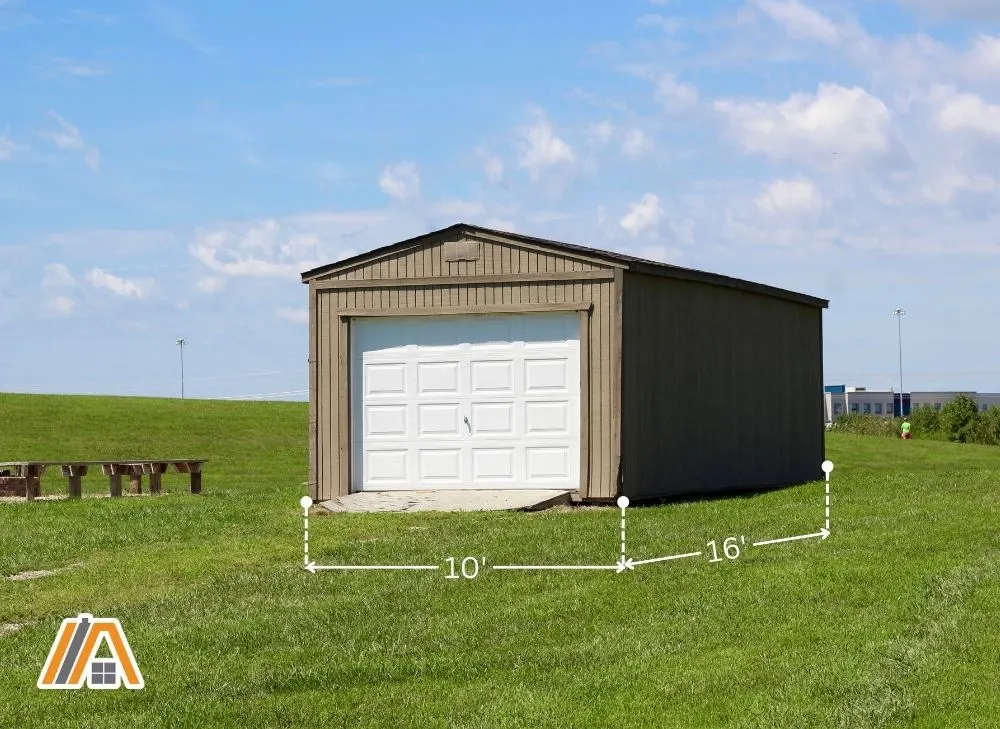
We will be calculating the internal measurements. We will not be accounting for doors and windows. The areas of these are easy to calculate, so you can add up the total area taken up by these, depending on the number and location and subtract this from the total area.
Stud Sizes
Along each 16-ft wall, you are going to lose 2 in. at each end for the first and last studs. This cuts the insulation area from 128 ft2 (16 ft x 8 ft) to 125.33 ft2 according to the following:
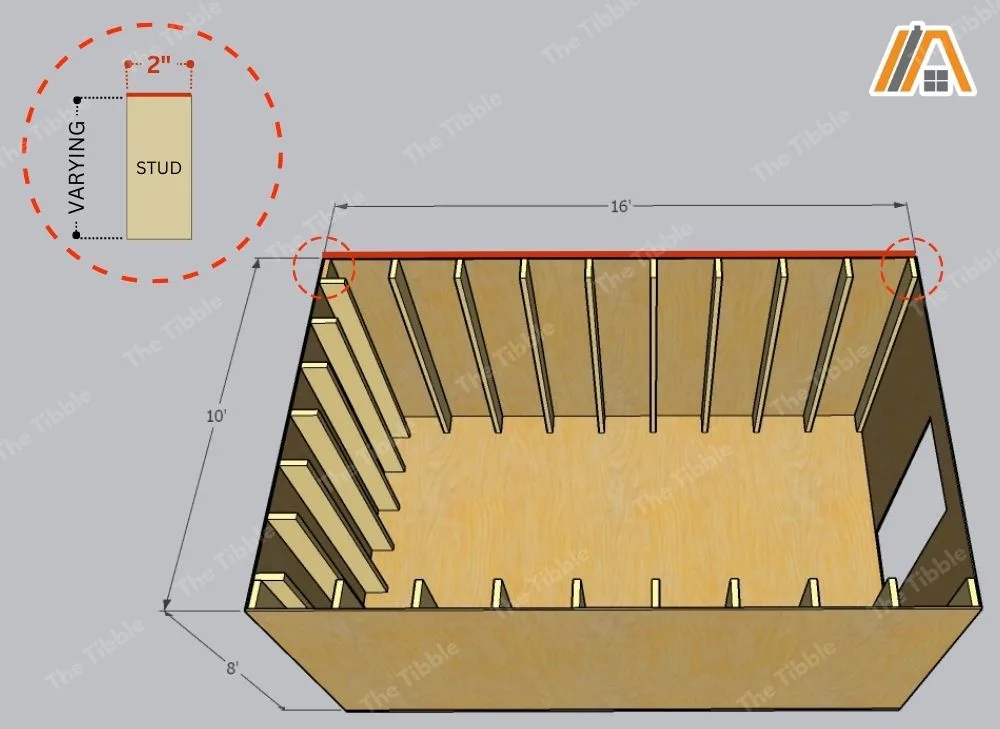
Calculation (1a): 16 ft x 12 = 192 in.
Calculation (1b): 192 in. – (2 + 2) in = 188 in.
Calculation (1c): 188 in. /12 = 15.67 ft
Calculation (1d): 15.67 ft x 8 ft = 125.33 ft2
Along each 10-ft wall, you are also going to lose 2 in. at each end for the first and last studs. This cuts the insulation area from 80 ft2 (10 ft x 8 ft) to 77.33 ft2 according to the following:
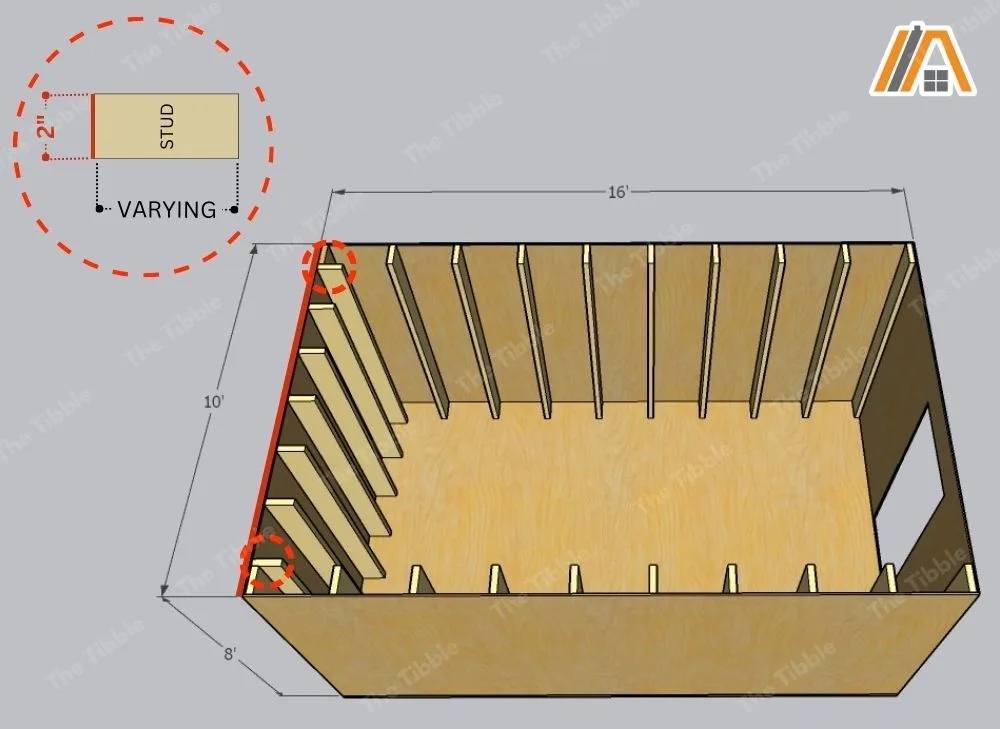
Calculation (2a): 10 ft x 12 = 120 in.
Calculation (2b): 120 in. – (2 + 2) in = 116 in.
Calculation (2c): 116 in. /12 = 9.67 ft
Calculation (2d): 9.67 ft x 8 ft = 77.33 ft2
In addition, you will lose the depth of one stud at each end. This accounts for the end studs of the long walls. The amount of space lost here depends on the size of the studs you use.
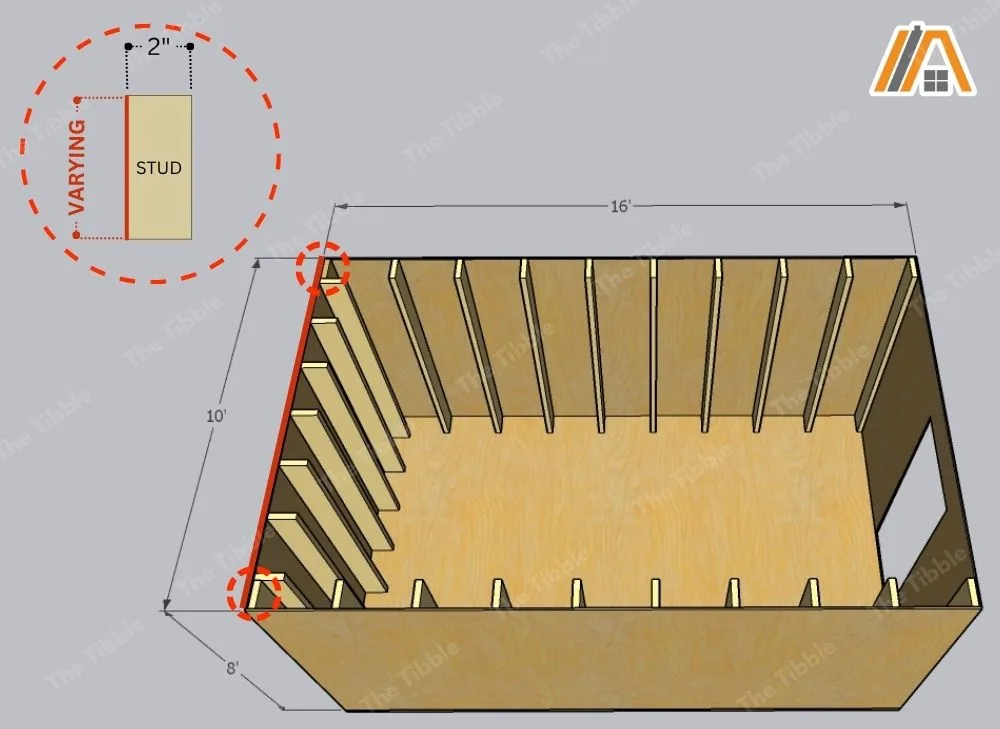
I imagine that for a shed, you’ve probably used 2×4, 2×6, or 2×8 studs. Anything larger and you lose too much space, particularly considering that there is no minimum insulation thickness/R-value requirements for a shed.
2×4, 2×6, or 2×8 studs means a loss of 8 in., 12 in., or 16 in., respectively.
Let’s plug these figures in the above equations. We will deduct them from the length in inches (given in Calculation (2b)).
For each 10-foot wall:
| New length | New length in feet | New area | |
| 2×4 studs | 116 in. – 8 in. = 108 in. | 180 in. /12 = 9 ft | 9 ft x 8 ft = 72 ft2 |
| 2×6 studs | 116 in. – 12 in. = 104 in. | 104 in. /12 = 8.67 ft | 8.67 ft x 8 ft = 69.33 ft2 |
| 2×8 studs | 116 in. – 16 in. = 100 in. | 100 in. /12 = 8.33 ft | 8.33 ft x 8 ft = 66.67 ft2 |
Stud Spacing
Then, of course, you must deduct the area used up by the rest of the studs along the wall. This depends on the number of studs used, and the number of studs used depends on the stud spacing chosen.
The recommended stud spacing for a shed wall is 16-24 in.
We’re going to look at the length available between the two end studs. So, for each 16-ft wall, this is 188 in. (Calculations (1b)) and for each 10-ft wall, it is 108 in., 104 in., and 100 in., depending on the stud size (Table 1).
For each 16-ft wall:
| 16 in. stud spacing | 18 in. stud spacing | 20 in. stud spacing | 22 in. stud spacing | 24 in. stud spacing |
| 11.75 studs | 10.44 studs | 9.4 studs | 8.55 studs | 7.83 studs |
| In real life, you would use 11 studs | In real life, you would use 10 studs | In real life, you would use 9 studs | In real life, you would use 9 studs | In real life, you would use 8 studs |
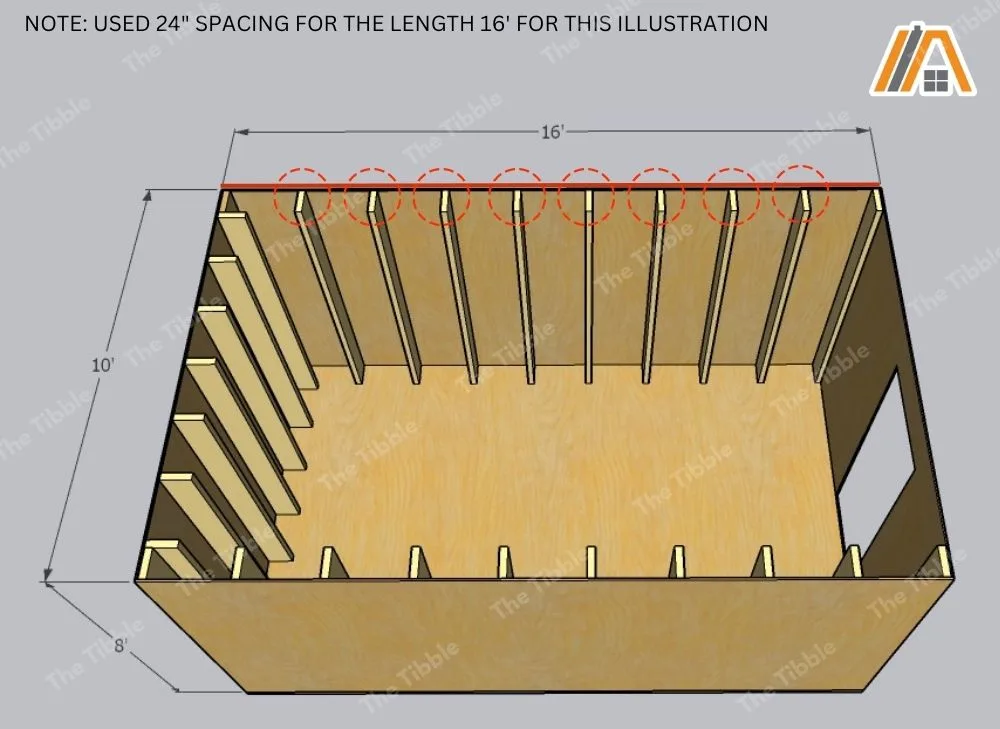
For each 10 ft wall:
| 16 in. stud spacing | 18 in. stud spacing | 20 in. stud spacing | 22 in. stud spacing | 24 in. stud spacing | |
| 2×4 studs | 6.75 studs (in real life, you would use 6 studs) | 6 studs | 5.4 studs (in real life, you would use 5 studs) | 4.9 studs (in real life, you would use 5 studs) | 4.5 studs (in real life, you would use 5 studs) |
| 2×6 studs | 6.5 studs (in real life, you would use 6 studs) | 5.78 studs (in real life, you would use 5 studs) | 5.2 studs (in real life, you would use 5 studs) | 4.73 studs (in real life, you would use 5 studs) | 4.33 studs (in real life, you would use 5 studs) |
| 2×8 studs | 6.25 studs (in real life, you would use 6 studs) | 5.56 studs (in real life, you would use 5 studs) | 5 studs | 4.55 studs (in real life, you would use 5 studs) | 4.17 studs (in real life, you would use 5 studs) |
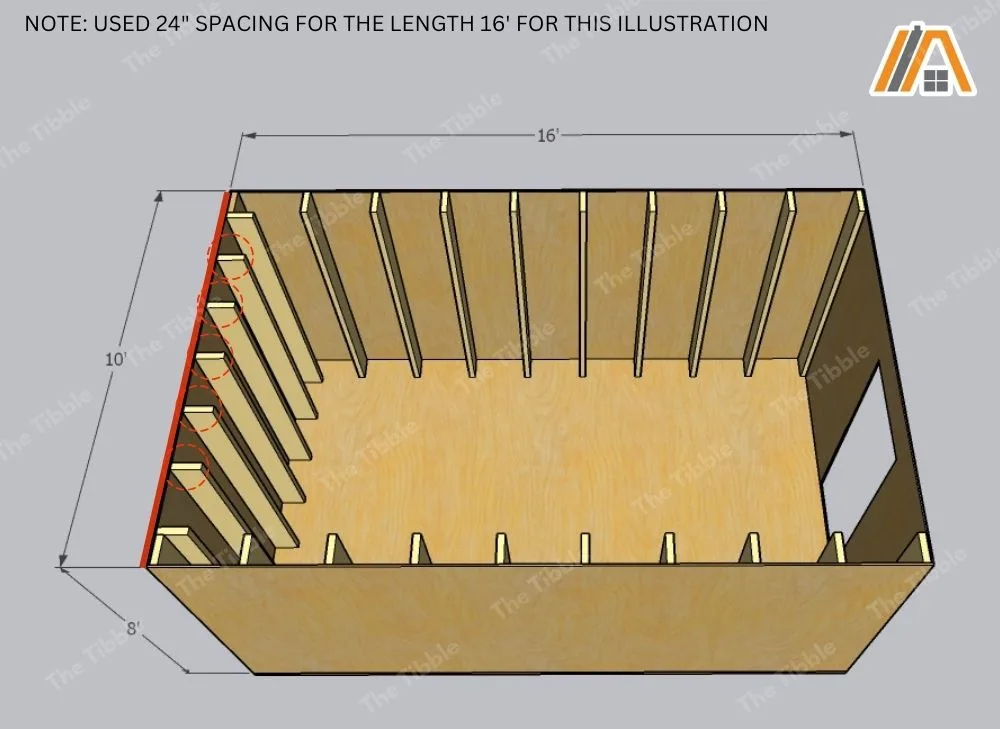
Total Wall Area to Cover
For each additional stud, you are going to subtract 2 in. from the total wall width. Multiplying this by the height will give you the total wall area needed to be covered by insulation.
For the 16-ft walls:
| Width excluding studs | Area requiring insulation (per wall) | Area requiring insulation (both walls) | |
| 11 studs | 166 in. = 13.83 ft | 110.67 ft2 | 221.34 ft2 |
| 10 studs | 168 in. = 14 ft | 112 ft2 | 224 ft2 |
| 9 studs | 170 in. = 14.17 ft | 113.33 ft2 | 226.66 ft2 |
| 8 studs | 172 in. = 14.33 ft | 114.67 ft2 | 229.34 ft2 |
For the 10-ft walls:
| Width excluding studs | Area requiring insulation (per wall) | Area requiring insulation (both walls) | |
| 6 studs | 2×4: 96 in. = 8 ft 2×6: 92 in. = 7.67 ft 2×8: 88 in. = 7.33 ft | 2×4: 64 ft2 2×6: 61.33 ft2 2×8: 58.67 ft2 | 2×4: 128 ft2 2×6: 122.66 ft2 2×8: 117.34 ft2 |
| 5 studs | 2×4: 98 in. = 8.17 ft 2×6: 94 in. = 7.83 ft 2×8: 90 in. = 7.5 ft | 2×4: 65.33 ft2 2×6: 62.67 ft2 2×8: 60 ft2 | 2×4: 130.66 ft2 2×6: 125.34 ft2 2×8: 120 ft2 |
For the walls in total:
| Stud spacing | 2×4 studs | 2×6 studs | 2×8 studs |
| 16 in. | 221.34 ft2 + 128 ft2 = 349.34 ft2 | 221.34 ft2 + 122.66 ft2 = 344 ft2 | 221.34 ft2 + 117.34 ft2 = 338.68 ft2 |
| 18 in. | 224 ft2 + 128 ft2 = 352 ft2 | 224 ft2 + 125.34 ft2 = 349.34 ft2 | 224 ft2 + 120 ft2 = 344 ft2 |
| 20 in. | 226.66 ft2 + 130.66 ft2 = 357.32 ft2 | 226.66 ft2 + 125.34 ft2 = 352 ft2 | 226.66 ft2 + 120 ft2 = 346.66 ft2 |
| 22 in. | 226.66 ft2 + 130.66 ft2 = 357.32 ft2 | 226.66 ft2 + 125.34 ft2 = 352 ft2 | 226.66 ft2 + 120 ft2 = 346.66 ft2 |
| 24 in. | 229.34 ft2 + 130.66 ft2 = 360 ft2 | 229.34 ft2 + 125.34 ft2 = 354.68 ft2 | 229.34 ft2 + 120 ft2 = 349.34 ft2 |
Calculating Actual Roof Area Requiring Insulation
For the roof, you also have to calculate the area minus the rafters.
However, things can get a little complicated because you have to take into account the roof design (gable, skillion, or flat). If you have a skillion or gable roof, the pitch adds additional area.
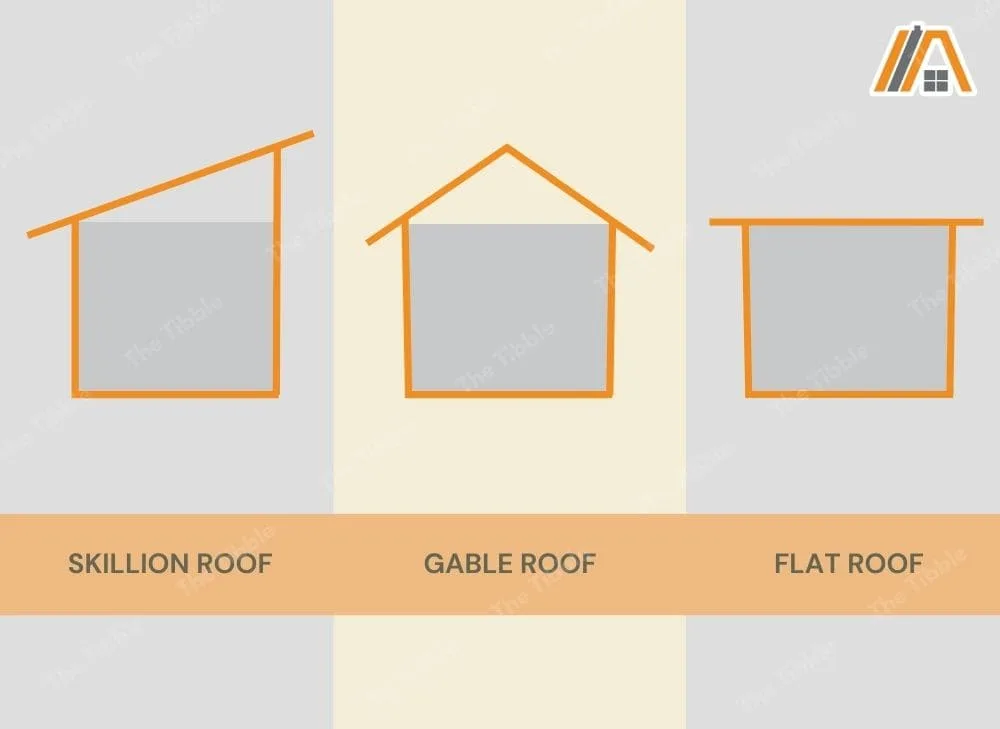
Flat Roofs
The area of the flat roof without rafters is going to be:
Calculation (3a): 10 ft x 16 ft = 160 ft2
However, you will be installing rafters, so we need to deduct the widths of these—insulation is only installed between the rafters.
Each rafter is 2 in. wide, installed parallel to the short edge (if you stood at the short end, you would see them crossing left to right), and the recommended rafter spacing for sheds is 16 in.
This means that we are looking at a starting width of:
Calculation (3b): 16 ft x 12 = 192 in.
Let’s deduct the width of the two end rafters as these have to be at the end and the rest of the rafters will be spaced between them.
Calculation (3c): 192 in. – 4 in. = 188 in.
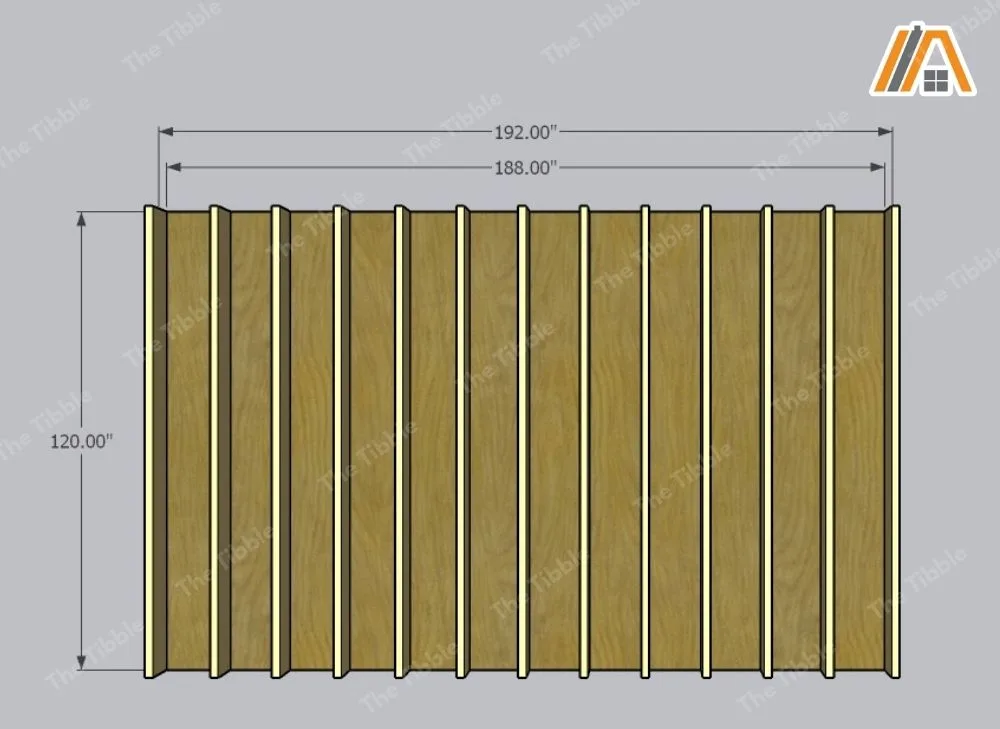
With a recommended spacing of 16 in., you will need 11.75 rafters (Table 2). Now, you can’t have a fraction of a rafter, so we’re going to round this down to 11 rafters.
You can round up to 12 if you choose, particularly if you are opting for a heavier roofing material, but 11 rafters should be sufficient in most cases.
Eleven rafters between the two end ones means an additional loss of:
Calculation (3d): 11 x 2 in. = 22 in.
Using this, we can calculate the area that insulation will be required to cover a flat roof for a 10×16 shed:
Calculation (4a): 188 in. – 22 in. = 166 in.
Calculation (4b): 166 in. /12 = 13.83 ft
Calculation (4c): 13.83 ft x 10 ft = 138.33 ft2
Gable Roofs
Roof Panels
The first thing that we have to look at here is the pitch. The minimum pitch you need is a 1/4 in. increase in rise (the distance from the ceiling line to the roof) for every foot of run (the distance from the edge of the building to the center of it).
However, this pitch means an angle of only 1.19°, which is unlikely to be the pitch you choose for your gable-roofed shed.
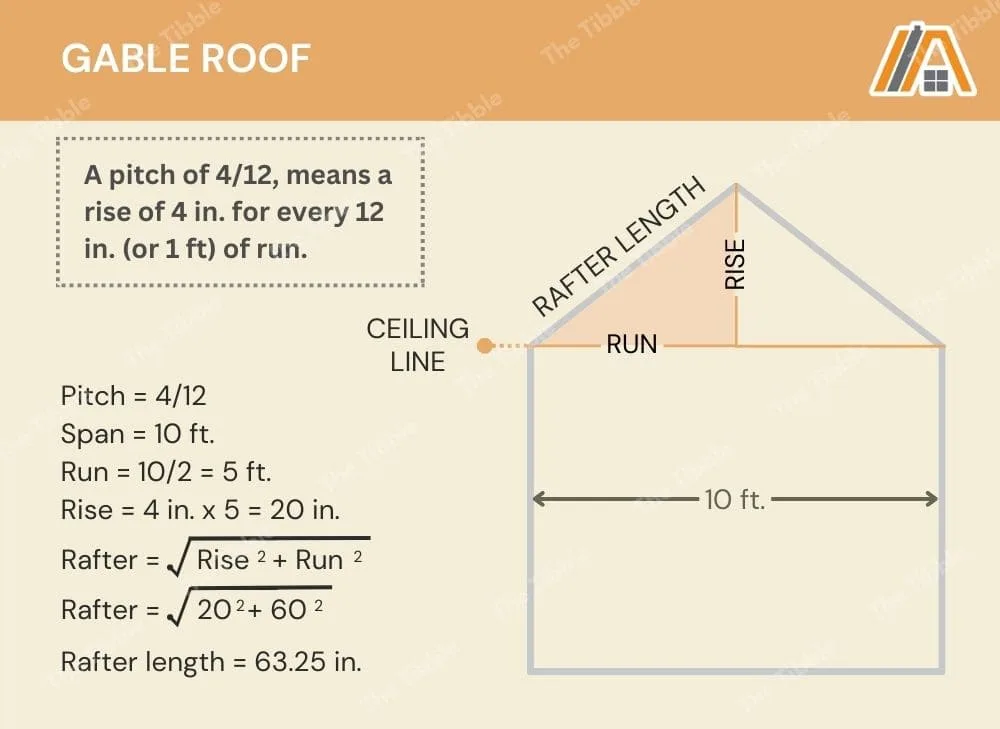
Instead, we will look at a pitch of 4/12, which means a rise of 4 in. for every 12 in. (or 1 ft) of run. This seems to be a common pitch used for gable-roofed sheds.
For a 10×16 shed, the run is:
Calculation (5a): 10 ft /2 = 5 ft
So, there are 5 x 1 ft lengths, which means the rise is calculated to be:
Calculation (5b): 4 in. x 5 = 20 in.
Using pythagoras’ theorem, we can use this to calculate the rafter length (represented as the hypotenuse).
Calculation (6a): Hypotenuse = √(adjacent)2 + (opposite)2
Calculation (6b): C = √(A)2 + (B)2
Calculation (6c): C = √(20)2 + (60)2
Calculation (6d): C = √400 + 3600
Calculation (6e): C = √4000
Calculation (6f): C = 63.25 in.
The rafter length up each side of the roof is, therefore, 63.25 in. or 5.27 ft.
The rafter spacing that is used for flat roofs is also used for gabled roofs. So, each side has 2 + 11 rafters, each with a width of 2 in.
We have already done this calculation in the section on flat roofs (Calculation (4b)). The roof width less the width of the rafters is 13.83 ft.
Thus, the area of each side that needs to be covered in insulation is:
Calculation (7a): 5.27 ft x 13.83 ft = 72.88 ft2
And the total area of the roof panels that required insulation covering is:
Calculation (7b): 72.88 ft2 x 2 = 145.76 ft2
Gable Spaces
As the roof has a peak, there are two triangles of space between the short walls and the apex of the roof. These spaces also needs to be insulated.
The space is reduced by the broad side of the rafters on each side of the peak, the broad side of a rafter set along the top of the wall (as if you were laying the first joist for a ceiling), and at least one upright beam that is set with the broad side out and which bisects the triangle.
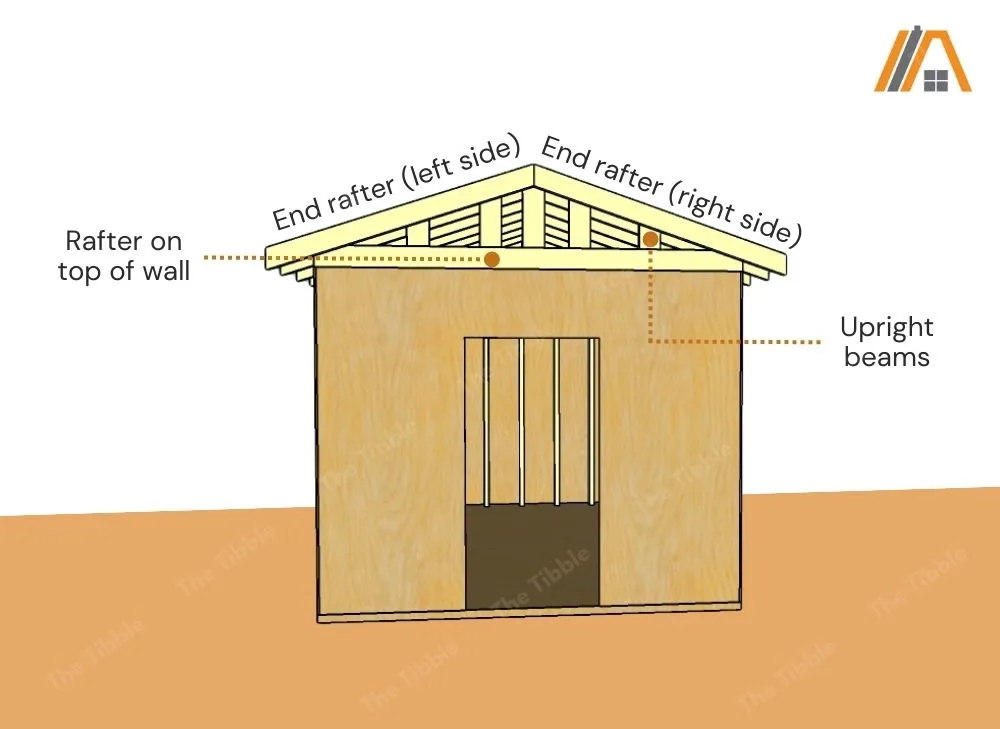
Because all of these beams are facing broad side out, the size of the beams comes into play.
You will most likely use 2×4 or 2×6 rafters.
The rise of 20 in. (Calculation (5b)) is reduced by:
- 8 in. at the top and bottom for 2×4 rafters
- 12 in. at the top and bottom for 2×6 rafters
This means that the rise of the space is:
- 12 in. if you are using 2×4 rafters
- 8 in. if you are using 2×6 rafters
While the rafters reduce the internal area of the triangular gable space, because they are all either 2×4 or 2×6, it does not alter the angles. (Triangles are great like that).
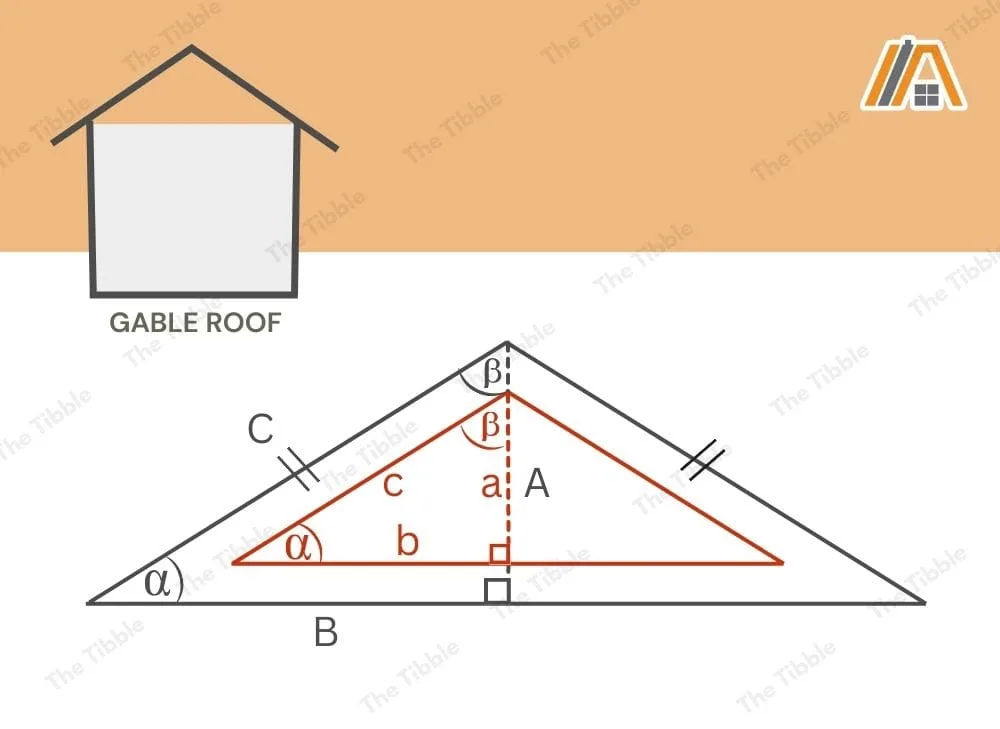
To calculate the area of these gable triangles, we need to know the values of a and b in the above diagram.
Here’s what we know:
- A = 20 in. (Calculation (5b))
- B = 5 ft = 60 in. (Calculation (5a))
- C = 63.25 in. (Calculation (6f))
We can calculate α using trigonometry:
Calculation (8a): sin(α) = opposite/hypotenuse
Calculation (8b): sin(α) = A/C
Calculation (8c): sin(α) = 20/63.25
Calculation (8d): sin(α) = 0.316205533
Calculation (8e): α = sin-1(0.316205533)
Calculation (8f): α = 18.43°
As stated previously, the angles of the larger triangle are the same for the smaller one.
To calculate the length of a, we need to subtract the top and bottom rafter dimensions.
I want to note here that this is not a fully accurate measurement because the center parallel beam means that we are not actually measuring through the proper central point.
However, once we have completed the rest of the calculations, I find it makes minimal difference.
So, for 2×4 rafters:
Calculation (9a): a = A – (2 x 4 in.)
Calculation (9b): a = 20 in. – 8 in.
Calculation (9c): a = 12 in.
And for 2×6 rafters:
Calculation (10a): a = A – (2 x 6 in.)
Calculation (10b): a = 20 in. – 12 in.
Calculation (10c): a = 8 in.
The area of a triangle is calculated as (base x height)/2. Base is b and height is a. We know a, so we need to calculate b. We are going to do this using more trigonometry.
For 2×4 rafters:
Calculation (11a): tan (α) = opposite/adjacent
Calculation (11b): tan (α) = a/b
Calculation (11c): tan (α) = 12/b
Calculation (11d): tan (18.43) = 12/b
Calculation (11e): 0.333237365 = 12/b
Calculation (11f): b = 12/0.333237365
Calculation (11g): b = 36.01 in.
From b, we are going to subtract half the parallel beam:
Calculation (11h): b = 36.01 in. – 2 in.
Calculation (11i): b = 34.01 in.
For 2×6 rafters:
Calculation (12a): tan (α) = opposite/adjacent
Calculation (12b): tan (α) = a/b
Calculation (12c): tan (α) = 8/b
Calculation (12d): tan (18.43) = 8/b
Calculation (12e): 0.333237365 = 8/b
Calculation (12f): b = 8/0.333237365
Calculation (12g): b = 24.01 in.
Again, we adjust for the central beam:
Calculation (12h): b = 24.01 in. – 3 in.
Calculation (12i): b = 21.01 in.
Now we can calculate the area of the triangles.
Remember that this is only for one side of the central parallel beam, so we need to double it at the end. Since the final step is to divide by two, we can essentially skip this step, but I will include it anyway.
Then, we have to double the number again for the opposite gable.
| 2×4 rafters | 2×6 rafters | |
| Area of half the gable | (base x height) /2 | (base x height) /2 |
| (b x a) /2 | (b x a) /2 | |
| (34.01 in. x 12 in.) /2 | (21.01 in. x 8 in.) /2 | |
| 408.12 in.2 /2 | 168.08 in.2 /2 | |
| 204.06 in.2 | 84.04 in.2 | |
| Area of one gable | 204.06 in.2 x 2 | 84.04 in.2 x 2 |
| 408.12 in.2 | 168.08 in.2 | |
| Area of one gable in ft2 | 2.83 ft2 | 1.17 ft2 |
| Total gable area | 2.83 ft2 x 2 | 1.17 ft2 x 2 |
| 5.66 ft2 | 2.34 ft2 |
Total Gable Roof Area Requiring Insulation
| 2×4 rafters | 2×6 rafters | |
| Roof panels | 145.76 ft2 | 145.76 ft2 |
| Gable spaces | 5.66 ft2 | 2.34 ft2 |
| Total area | 151.42 ft2 | 148.1 ft2 |
Skillion Roofs
Roof Panel
Again, we start with pitch. Skillion roofs are not going to be as steeply pitched as gable roofs. A common pitch angle for these shed roofs is 10°, so this is what we will use for the calculations.
You can always insert your actual roof pitch into the equations to calculate the area for your roof if it is not 10°.
We first need to calculate the length of the roof. This is the triangle hypotenuse (C) as illustrated below.
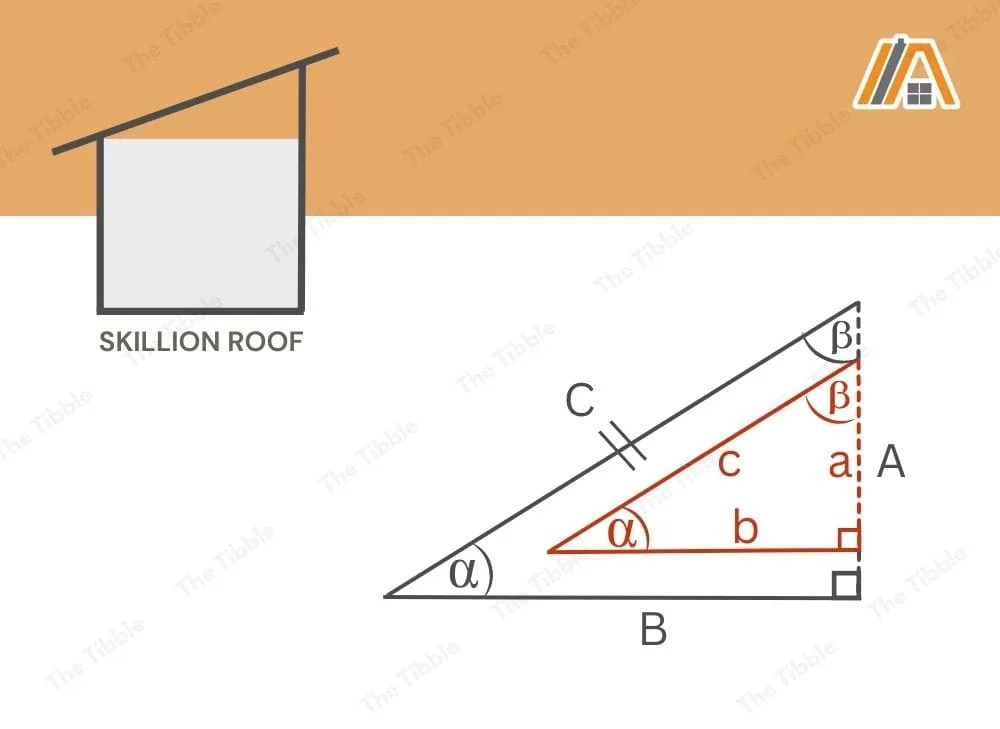
We know the angle α (10°) and the dimension B (10 ft). This means that we can use trigonometry to calculate C.
Calculation (13a): cos(α) = adjacent /hypotenuse
Calculation (13b): cos(α) = B /C
Calculation (13c): cos(10) = 10 ft /C
Calculation (13d): 0.984807753 = 10 ft /C
Calculation (13e): C = 10 ft /0.984807753
Calculation (13f): C = 10.15 ft
Using this and the known width of 16 ft, we can calculate the area of the roof panel without rafters.
Calculation (14a): 10.15 ft x 16 ft = 162.4 ft2
But there are most certainly rafters, so we need to adjust for these.
Each rafter is 2 in. in width. The same spacing applies as before (16 in.). We have actually already calculated the width of the roof minus the the width of the rafters (Calculations (3b), (3c), (3d), (4a), and (4b)).
This width is 13.83 ft. The area of skillion roof panels for a 10×16 shed requiring insulation covering is:
Calculation (14b): 10.15 ft x 13.83 ft = 140.37 ft2
Gable Spaces
Even though this is not a gable roof, there are still those triangles on the side that need to be insulated.
We need to calculate the area of the small triangle in the sketch above. The area is decreased by the broad side of a rafter beam along the edge of the roof panel, the top of the wall at the ceiling line, and the rise.
Again, we can calculate a as A minus the breadth of the beam at the top and bottom of the space. This means it is time to consider the rafter sizes (2×4 and 2×6).
This time, we don’t actually know A, so we need to start here:
Calculation (15a): tan(α) = opposite /adjacent
Calculation (15b): tan(α) = A /B
Calculation (15c): tan(10) = A /10 ft
Calculation (15d): 0.17632698 = A /10 ft
Calculation (15e): A = 10 ft x 0.17632698
Calculation (15f): A = 1.76 ft
Let’s convert this to inches so that we can subtract the rafter breadths (given in inches). 1.76 ft is 21.12 in.
Calculating a for 2×4 rafters:
Calculation (16a): a = A – (2 x 4 in.)
Calculation (16b): a = 21.12 in. – 8 in.
Calculation (16c): a = 13.12 in.
Calculation (16d): 13.12 in. /12 = 1.09 ft
Calculating a for 2×6 rafters:
Calculation (17a): a = A – (2 x 6 in.)
Calculation (17b): a = 21.12 in. – 12 in.
Calculation (17c): a = 9.12 in.
Calculation (17d): 9.12 in. /12 = 0.76 ft
To find the area of the small triangle, we also need to know the base length, which is b.
For 2×4 rafters:
Calculation (18a): tan(α) = opposite /adjacent
Calculation (18b): tan(α) = a /b
Calculation (18c): tan(10) = 1.09 ft /b
Calculation (18d): 0.17632698 = 1.09 ft /b
Calculation (18e): b = 1.09 ft /0.17632698
Calculation (18f): b = 6.18 ft
For 2×6 rafters:
Calculation (19a): tan(α) = opposite /adjacent
Calculation (19b): tan(α) = a /b
Calculation (19c): tan(10) = 0.76 ft /b
Calculation (19d): 0.17632698 = 0.76 ft /b
Calculation (19e): b = 0.76 ft /0.17632698
Calculation (19f): b = 4.31 ft
Now we can calculate the area of one gable space and multiply it by two (to account for the opposite space) to get the total gable area.
| 2×4 rafters | 2×6 rafters | |
| Area of the gable space | (base x height) /2 | (base x height) /2 |
| (b x a) /2 | (b x a) /2 | |
| (6.18 ft x 1.09 ft) /2 | (4.31 ft x 0.76 ft) /2 | |
| 6.74 ft2 /2 | 3.28 ft2 /2 | |
| 3.37 ft2 | 1.64 ft2 | |
| Total gable area | 3.37 ft2 x 2 | 1.64 ft2 x 2 |
| 6.74 ft2 | 3.28 ft2 |
Wall Extension
We’re not done yet! With skillion roofs, we also have to insulate the side of the roof that is essentially an extension of the one 16-ft wall.
Happily, this is a straightforward calculation.
The wall extension is 16 ft wide, less the stud widths. We already have these calculated in Table 4:
- When 11 studs are used (16 in. stud spacing), the width is 13.83 ft
- When 10 studs are used (18 in. stud spacing), the width is 14 ft
- When 9 studs are used (20 in. and 22 in. stud spacing), the width is 14.17 ft
- When 8 studs are used (24 in. stud spacing), the width is 14.33 ft
The height is equal to the rise (A), which is 1.76 ft.
So, the total wall extension area requiring insulation coverage is:
| Area | |
| 11 studs; 16 in. stud spacing | 1.76 ft x 13.83 ft = 24.34 ft2 |
| 10 studs; 18 in. stud spacing | 1.76 ft x 14 ft = 24.64 ft2 |
| 9 studs; 20 in. and 22 in. stud spacing | 1.76 ft x 14.17 ft = 24.94 ft2 |
| 8 studs; 24 in. stud spacing | 1.76 ft x 14.33 ft = 25.22 ft2 |
Total Skillion Roof Area and New Wall Area
For ease, we will incorporate the wall extension area into the total wall area instead of the total roof area. Below is an extension of Table 6.
| Stud spacing | 2×4 studs | 2×6 studs | 2×8 studs |
| 16 in. | 349.34 ft2 + 24.34 ft2 = 373.68 ft2 | 344 ft2 + 24.34 ft2 = 368.34 ft2 | 338.68 ft2 + 24.34 ft2 = 363.02 ft2 |
| 18 in. | 352 ft2 + 24.64 ft2 = 376.64 ft2 | 349.34 ft2 + 24.64 ft2 = 373.98 ft2 | 344 ft2 + 24.64 ft2 = 368.64 ft2 |
| 20 in. | 357.32 ft2 + 24.94 ft2 = 382.26 ft2 | 352 ft2 + 24.94 ft2 = 376.94 ft2 | 346.66 ft2 + 24.94 ft2 = 371.6 ft2 |
| 22 in. | 357.32 ft2 + 24.94 ft2 = 382.26 ft2 | 352 ft2 + 24.94 ft2 = 376.94 ft2 | 346.66 ft2 + 24.94 ft2 = 371.6 ft2 |
| 24 in. | 360 ft2 + 25.22 ft2 = 385.22 ft2 | 354.68 ft2 + 25.22 ft2 = 379.9 ft2 | 349.34 ft2 + 25.22 ft2 = 374.56 ft2 |
Now for the total skillion roof area for 10×16 shed:
| Roof panel area | Gable space area | Total roof area | |
| 2×4 | 140.37 ft2 | 6.74 ft2 | 147.11 ft2 |
| 2×6 | 140.37 ft2 | 3.28 ft2 | 143.65 ft2 |
These calculations can be used to work out the amount of insulation required for sheds of different sizes, like 10×12.
Amount of Insulation Required to Insulate 10×16 Shed
Flat Roof
2×4 Studs
| Stud spacing | Wall area | Roof area | Total area |
| 16 in. | 349.34 ft2 | 138.33 ft2 | 487.67 ft2 |
| 18 in. | 352 ft2 | 138.33 ft2 | 490.33 ft2 |
| 20 in. | 357.32 ft2 | 138.33 ft2 | 495.65 ft2 |
| 22 in. | 357.32 ft2 | 138.33 ft2 | 495.65 ft2 |
| 24 in. | 360 ft2 | 138.33 ft2 | 498.33 ft2 |
2×6 Studs
| Stud spacing | Wall area | Roof area | Total area |
| 16 in. | 344 ft2 | 138.33 ft2 | 482.33 ft2 |
| 18 in. | 349.34 ft2 | 138.33 ft2 | 487.67 ft2 |
| 20 in. | 352 ft2 | 138.33 ft2 | 490.33 ft2 |
| 22 in. | 352 ft2 | 138.33 ft2 | 490.33 ft2 |
| 24 in. | 354.68 ft2 | 138.33 ft2 | 493.01 ft2 |
2×8 Studs
| Stud spacing | Wall area | Roof area | Total area |
| 16 in. | 338.68 ft2 | 138.33 ft2 | 477.01 ft2 |
| 18 in. | 344 ft2 | 138.33 ft2 | 482.33 ft2 |
| 20 in. | 346.66 ft2 | 138.33 ft2 | 484.99 ft2 |
| 22 in. | 346.66 ft2 | 138.33 ft2 | 484.99 ft2 |
| 24 in. | 349.34 ft2 | 138.33 ft2 | 487.67 ft2 |
Gable Roof
2×4 Rafters and 2×4 Studs
| Stud spacing | Wall area | Roof area | Total area |
| 16 in. | 349.34 ft2 | 151.42 ft2 | 500.76 ft2 |
| 18 in. | 352 ft2 | 151.42 ft2 | 503.42 ft2 |
| 20 in. | 357.32 ft2 | 151.42 ft2 | 508.74 ft2 |
| 22 in. | 357.32 ft2 | 151.42 ft2 | 508.74 ft2 |
| 24 in. | 360 ft2 | 151.42 ft2 | 511.42 ft2 |
2×4 Rafters and 2×6 Studs
| Stud spacing | Wall area | Roof area | Total area |
| 16 in. | 344 ft2 | 151.42 ft2 | 495.42 ft2 |
| 18 in. | 349.34 ft2 | 151.42 ft2 | 500.76 ft2 |
| 20 in. | 352 ft2 | 151.42 ft2 | 503.42 ft2 |
| 22 in. | 352 ft2 | 151.42 ft2 | 503.42 ft2 |
| 24 in. | 354.68 ft2 | 151.42 ft2 | 506.1 ft2 |
2×4 Rafters and 2×8 Studs
| Stud spacing | Wall area | Roof area | Total area |
| 16 in. | 338.68 ft2 | 151.42 ft2 | 490.01 ft2 |
| 18 in. | 344 ft2 | 151.42 ft2 | 495.42 ft2 |
| 20 in. | 346.66 ft2 | 151.42 ft2 | 498.08 ft2 |
| 22 in. | 346.66 ft2 | 151.42 ft2 | 498.08 ft2 |
| 24 in. | 349.34 ft2 | 151.42 ft2 | 500.76 ft2 |
2×6 Rafters and 2×4 Studs
| Stud spacing | Wall area | Roof area | Total area |
| 16 in. | 349.34 ft2 | 148.1 ft2 | 497.44 ft2 |
| 18 in. | 352 ft2 | 148.1 ft2 | 500.1 ft2 |
| 20 in. | 357.32 ft2 | 148.1 ft2 | 505.52 ft2 |
| 22 in. | 357.32 ft2 | 148.1 ft2 | 505.52 ft2 |
| 24 in. | 360 ft2 | 148.1 ft2 | 508.1 ft2 |
2×6 Rafters and 2×6 Studs
| Stud spacing | Wall area | Roof area | Total area |
| 16 in. | 344 ft2 | 148.1 ft2 | 492.1 ft2 |
| 18 in. | 349.34 ft2 | 148.1 ft2 | 497.44 ft2 |
| 20 in. | 352 ft2 | 148.1 ft2 | 500.1 ft2 |
| 22 in. | 352 ft2 | 148.1 ft2 | 500.1 ft2 |
| 24 in. | 354.68 ft2 | 148.1 ft2 | 502.48 ft2 |
2×6 Rafters and 2×8 Studs
| Stud spacing | Wall area | Roof area | Total area |
| 16 in. | 338.68 ft2 | 148.1 ft2 | 486.78 ft2 |
| 18 in. | 344 ft2 | 148.1 ft2 | 492.1 ft2 |
| 20 in. | 346.66 ft2 | 148.1 ft2 | 494.76 ft2 |
| 22 in. | 346.66 ft2 | 148.1 ft2 | 494.76 ft2 |
| 24 in. | 349.34 ft2 | 148.1 ft2 | 497.44 ft2 |
Skillion Roof
2×4 Rafters and 2×4 Studs
| Stud spacing | Wall area | Roof area | Total area |
| 16 in. | 373.68 ft2 | 147.11 ft2 | 520.79 ft2 |
| 18 in. | 376.64 ft2 | 147.11 ft2 | 523.75 ft2 |
| 20 in. | 382.26 ft2 | 147.11 ft2 | 529.37 ft2 |
| 22 in. | 382.26 ft2 | 147.11 ft2 | 529.37 ft2 |
| 24 in. | 385.26 ft2 | 147.11 ft2 | 532.37 ft2 |
2×4 Rafters and 2×6 Studs
| Stud spacing | Wall area | Roof area | Total area |
| 16 in. | 368.34 ft2 | 147.11 ft2 | 515.45 ft2 |
| 18 in. | 373.98 ft2 | 147.11 ft2 | 521.09 ft2 |
| 20 in. | 376.94 ft2 | 147.11 ft2 | 524.05 ft2 |
| 22 in. | 376.94 ft2 | 147.11 ft2 | 524.05 ft2 |
| 24 in. | 379.9 ft2 | 147.11 ft2 | 527.01 ft2 |
2×4 Rafters and 2×8 Studs
| Stud spacing | Wall area | Roof area | Total area |
| 16 in. | 363.02 ft2 | 147.11 ft2 | 510.13 ft2 |
| 18 in. | 368.64 ft2 | 147.11 ft2 | 515.75 ft2 |
| 20 in. | 371.6 ft2 | 147.11 ft2 | 518.71 ft2 |
| 22 in. | 371.6 ft2 | 147.11 ft2 | 518.71 ft2 |
| 24 in. | 374.56 ft2 | 147.11 ft2 | 521.67 ft2 |
2×6 Rafters and 2×4 Studs
| Stud spacing | Wall area | Roof area | Total area |
| 16 in. | 373.68 ft2 | 143.65 ft2 | 517.33 ft2 |
| 18 in. | 376.64 ft2 | 143.65 ft2 | 520.29 ft2 |
| 20 in. | 382.26 ft2 | 143.65 ft2 | 525.91 ft2 |
| 22 in. | 382.26 ft2 | 143.65 ft2 | 525.91 ft2 |
| 24 in. | 385.26 ft2 | 143.65 ft2 | 528.91 ft2 |
2×6 Rafters and 2×6 Studs
| Stud spacing | Wall area | Roof area | Total area |
| 16 in. | 368.34 ft2 | 143.65 ft2 | 511.99 ft2 |
| 18 in. | 373.98 ft2 | 143.65 ft2 | 517.63 ft2 |
| 20 in. | 376.94 ft2 | 143.65 ft2 | 520.59 ft2 |
| 22 in. | 376.94 ft2 | 143.65 ft2 | 520.59 ft2 |
| 24 in. | 379.9 ft2 | 143.65 ft2 | 523.55 ft2 |
2×6 Rafters and 2×8 Studs
| Stud spacing | Wall area | Roof area | Total area |
| 16 in. | 363.02 ft2 | 143.65 ft2 | 506.67 ft2 |
| 18 in. | 368.64 ft2 | 143.65 ft2 | 512.29 ft2 |
| 20 in. | 371.6 ft2 | 143.65 ft2 | 515.25 ft2 |
| 22 in. | 371.6 ft2 | 143.65 ft2 | 515.25 ft2 |
| 24 in. | 374.56 ft2 | 143.65 ft2 | 518.21 ft2 |
If you are insulating a shed, you should also consider ventilating it. There are a number of ways to achieve this.
